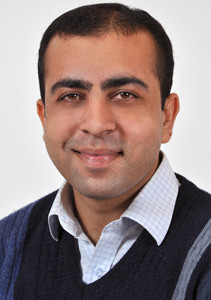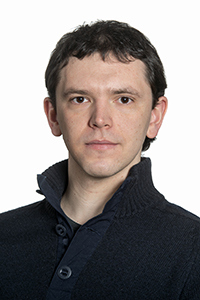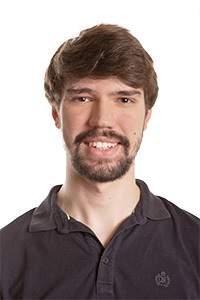Polymeric E-textiles
We take a broad view, from what materials are suitable for generating various smart functions to how to make functional textile fibres from these and how these fibres can be assembled into textile constructions and structures with new properties. We also look at how textile systems can be produced and applied in different contexts; this can relate to water purification, sustainability, or medical applications.
We work with all textile processes; weaving, knitting, braiding, coating, sewing, embroidery, lamination, etc. Both more basic research and applied projects in collaboration with commerce and industry are conducted. A consulting role in smart textiles is also an important part of our work. The group has a very strong position when it comes to smart textiles both in projects and networking both in Sweden and abroad; this has been built up over the last decade by Nils-Krister Persson at Smart Textiles.
Research in several areas is conducted.
Fibre Technology
Fibre technology primarily involves studies on and the development of textile fibres, filaments and yarns for electrical (electron, hole and ion) conductivity. Central is the use of polymeric thiophene systems. Carbon allomorphs have also been used recently. A pilot line is constructed for the production of larger quantities of conductive fibres with a continuous current path. These fibres must be of such a quality that they can be used in industry-relevant weaving and knitting processes. Fibretronics is a theme that has developed in which various electrical components are realised on the fibre level and in fibre form. This is related to the logic of integration that has been developed, with integration into (the textile itself carries a function) and integration on (the textile is merely a carrier); the former is our main focus.
Water treatment
Textiles allow large surfaces to be manufactured cheaply and with high precision. Fabrics can be effectively functionalised in a variety of ways. This is the basis for using textiles for water treatment, in which typically large volumes and thus surfaces need to be dealt with, and in which portability can be valuable (e.g. a roll-up system can be taken to a rapidly-developed emission source, be effective there for some time, and then be taken away with the pollution in question) and in which biocompatibility and the possibility of draping and dressing ponds, canals and stormwater wells is advantageous. When it comes to water treatment, we have worked in two directions: 1) photocatalytic textile systems for water purification regarding biological contamination and 2) use of grown organisms (fungi and algae). In this latter case, Waterweave was conceived; this works to develop textiles functionalised with an organism capable of biosorbing heavy metals. Originally, the usage was in the handling of leachate from landfills, but now it deals with stormwater as a result of legislation at the European level and the fact that more and more surfaces have become hardened in the urban environment. Waterweave has been based at Chalmers Venture and Stena Center in Gothenburg prior to being part of projects within Chalmers School of Entrepreneurship and it has received funding from Vinnova and won the Venture Cup. The project was nominated to the World 100 most innovative ideas 2015, Paris.
Textile photonics
One theme within the group is the use of textile structures for generating and modifying electromagnetic fields. The area connects to fibre technology as different electrical conductivity properties are central. Previously, photonic bandgap structures have been woven. Textiles have been characterised for the THz range. Woven antennas have been demonstrated and they not only work but can also be produced as a textile on the meter.
Dynamic textiles
Dynamic textiles are one of the group's major theme areas and here we have been pioneers and hold an internationally leading position after previous publication in the well-known journal Science Advances. Traditionally, textiles are passive and movement arises as a result of the mechanical impact of external factors. We have shown that textiles can be made active; that the fabric itself, internally, can be given the ability to exert force and change extensions. This is equivalent to the control of both tension and elongation. The resemblance to mammal muscles is evident in that it consists of muscle fibres and, like our system, is controlled electrically and acts via contraction. The term “textile muscles” is therefore reasonable. We are now developing new textile constructions for this.
Textile exoskeleton is a related theme; here the system for the forearm has been in focus. Two different mechanisms have been built and analysed: an electrical wire system and a McKibben system. Two large externally funded projects focus on this area.
Haptic technology
Haptics is the study of touch. Currently, interest in new forms of communication is increasing beyond the traditional visual and audio modalities. Haptics and haptic communication are a means for this. Textiles are closely associated with haptic experiences as they have contact with the entire body, and textiles are therefore a very interesting option for haptic technology. The research group participates in externally funded projects in the area aimed at different groups with disabilities. We integrate various elements into and onto textiles, which are thereby given the ability to interact with the wearer. These days, one talks about various modalities, e.g. thermal, vibration, pressure etc. In this area, we also work internationally with leading groups within psychophysics to study human discernment when it comes to different stimuli.
Microfluidics
The field of microfluidics is a large scientific field at the interface of physical chemistry, medicine, and chemical biology. Biosensors are a result. PDMS (silicone rubber) and etching techniques are typically used. However, the group has instead developed a textile system in which liquid can be controlled with high reproducibility in a weave and all this has been shown to be able to be manufactured efficiently on fabric. Much greater freedom can be achieved with textile manufacturing than with, for example, printed electronics. Thus, textile biosensors can be achieved. Textile microfluidic circuits can be used in sampling when it comes to environmental monitoring, the food industry, veterinary medicine, or in the cultivation in traditional agriculture or in the urban environment.
Textile sensors
The group is active in the integration of sensors into textiles. Mainly, the focus is on medical applications. One major theme is individually-tailored lower limb devices. A holistic perspective is used in production, starting with 3D scanning; grants were received for special equipment, and directly thereafter comes pattern design, followed by the production of examples. Companies have collaborated with us on this. Textile electrode materials have been developed and been given different properties. For example, in a collaboration with Karolinska University Hospital, socks made from second-generation smart textiles have been developed, where not only the sensor part is in focus but the textile is itself a medical treatment.
To a lesser extent, scientific work when it comes to innovation is also taking place; in particular, an analysis of the innovation path has been of interest and regarding which ontological entities are necessary and which are optional. Artefact theory has also been applied to the innovation process, partly when it comes to sustainability within the Re: area (reduce, reuse, recycle).








